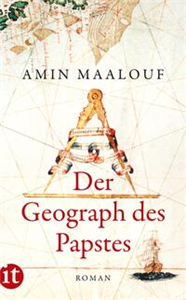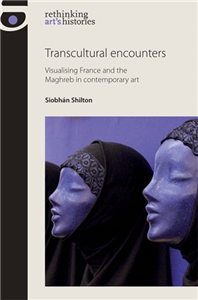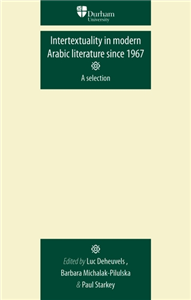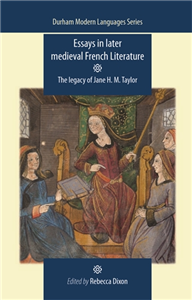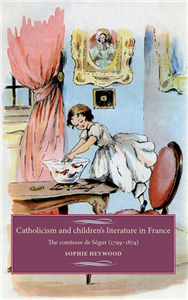Your Search Results
-
Magic Author
We are a one-stop platform to read, write, self-publish and sell ebooks in any of the Indian languages. Our mission is to empower the author's community with the digital tools and techniques, and we take care of the online presence of professionals in the publishing landscape, be they authors, publishers, editors, designers, publicists, etc.
View Rights Portal
-
Promoted ContentLiterature & Literary StudiesMarch 2023
Sleep and its spaces in Middle English literature
Emotions, ethics, dreams
by Megan Leitch
Middle English literature is intimately concerned with sleep and the spaces in which it takes place. In the medieval English imagination, sleep is an embodied and culturally determined act. It is both performed and interpreted by characters and contemporaries, subject to a particular habitus and understood through particular hermeneutic lenses. While illuminating the intersecting medical and moral discourses by which it is shaped, sleep also sheds light on subjects in favour of which it has hitherto been overlooked: what sleep can enable (dreams and dream poetry) or what it can stand in for or supersede (desire and sex). This book argues that sleep mediates thematic concerns and questions in ways that have ethical, affective and oneiric implications. At the same time, it offers important contributions to understanding different Middle English genres: romance, dream vision, drama and fabliau.
-
Promoted ContentLiterature & Literary StudiesDecember 2019
Reimagining North African immigration
by Véronique Machelidon, Patrick Saveau
-
 Trusted Partner
May 2012
Trusted Partner
May 2012Der Geograph des Papstes
Leo Africanus
by Amin Maalouf, Nicola Volland, Bettina Klingler
»Ich bin ein Sohn der Straße, meine Heimat ist die Karawane, und mein Leben ist eine Reise voller Überraschungen.« Hassan al-Wazzan, ein gebildeter junger Mann und gläubiger Muslim, bereist als Kaufmann den Maghreb und hat den großen Wunsch, nach Mekka zu pilgern. Doch es sind unruhige Zeiten in einer unruhigen Gegend, es herrschen Überfälle und Kriege. Wie aus dem Nichts taucht eines Tages eine Bande sizilianischer Piraten auf, die Hassan nach Rom verschleppen und versklaven. Er ist ein Glücksgriff für die Piraten, denn Hassans wacher Verstand und seine außergewöhnliche Klugheit machen ihn zu einem besonderen Geschenk für den mächtigsten Mann der christlichen Welt: Papst Leo X. Dieser ernennt ihn zu seinem Geographen – doch wird er dem Vatikan jemals wieder entkommen können, seine Freiheit zurückerlangen und in seine Heimat, den Maghreb, zurückkehren? »Der Geograph des Papstes« ist ein ungemein packender historischer Roman, der die ereignisreiche und hochspannende Epoche der Renaissance lebendig werden läßt.
-
 Trusted Partner
Literature & Literary StudiesOctober 2002
Trusted Partner
Literature & Literary StudiesOctober 2002The question of literature
The place of the literary in contemporary theory
by Gerard Greenway, Elizabeth Beaumont-Bissell
As literary theory has grown more influential, interdisciplinary and sophisticated, it has come to concern itself with a much greater range of issues and objects than those traditionally considered literary. It now addresses philosophy, history, psychology, politics and the media. Addressing a central and fundamental, but relatively neglected, issue in literary theory, this title seeks to recontextualise how theory has changed our understanding of literature and its questions by relating literature to the institution of the university, to ethical judgements and values, new media and computer technology and the nature of representative democracy. ;
-
 Trusted Partner
The ArtsApril 2013
Trusted Partner
The ArtsApril 2013Transcultural encounters
Visualising France and the Maghreb in contemporary art
by Siobhán Shilton, Amelia Jones, Marsha Meskimmon
Art since the 1980s reveals a striking proliferation of works exploring the complex cross-cultural identities that have resulted from a long history of exchange between France and the Maghreb. This adventurous study examines distinctively visual means of presenting 'Franco-Maghrebi' identities in performance, video, photography and installation art. Transcultural encounters investigates the ways in which such art spurs a re-thinking of both postcolonial and feminist issues and critical terms in an uneven globalised frame. It demonstrates how this corpus develops art historical debates concerning gender and representation, while also considering emerging visions of the Maghreb. Analysing a wide range of works presented in galleries, online or in the street, this study shows how they test the boundaries of established art genres, calling for the invention of new modalities of 'reading' transnational visual culture. The first book to explore postcolonial and feminist approaches to contemporary art from a 'Francophone' space, Transcultural encounters incorporates much material that has previously received little critical attention. The book will be of interest to researchers in French studies, postcolonial studies, visual studies and gender studies, as well as curators and artists working across cultures and media. ;
-
 Trusted Partner
Literature & Literary StudiesMarch 2017
Trusted Partner
Literature & Literary StudiesMarch 2017Imperialism and juvenile literature
by Jeffrey Richards
Popular culture is invariably a vehicle for the dominant ideas of its age. Never was this truer than in the late-nineteenth and early twentieth centuries, when it reflected the nationalist and imperialist ideologies current throughout Europe. It both reflects popular attitudes, ideas and preconceptions and it generates support for selected views and opinions. This book examines the various media through which nationalist ideas were conveyed in late-Victorian and Edwardian times: in the theatre, "ethnic" shows, juvenile literature, education and the iconography of popular art. It seeks to examine in detail the articulation and diffusion of imperialism in the field of juvenile literature by stressing its pervasiveness across boundaries of class, nation and gender. It analyses the production, distribution and marketing of imperially-charged juvenile fiction, stressing the significance of the Victorians' discovery of adolescence, technological advance and educational reforms as the context of the great expansion of such literature. An overview of the phenomenon of Robinson Crusoe follows, tracing the process of its transformation into a classic text of imperialism and imperial masculinity for boys. The imperial commitment took to the air in the form of the heroic airmen of inter-war fiction. The book highlights that athleticism, imperialism and militarism become enmeshed at the public schools. It also explores the promotion of imperialism and imperialist role models in fiction for girls, particularly Girl Guide stories.
-
 Trusted Partner
Humanities & Social SciencesSeptember 2020
Trusted Partner
Humanities & Social SciencesSeptember 2020Queer Muslim diasporas in contemporary literature and film
by Alberto Fernández Carbajal, Amina Yaqin
-
 Trusted Partner
Literature & Literary StudiesJune 2021
Trusted Partner
Literature & Literary StudiesJune 2021Sleep and its spaces in Middle English literature
by Megan Leitch, Anke Bernau, David Matthews, James Paz
-
 Trusted Partner
Literature & Literary StudiesDecember 2009
Trusted Partner
Literature & Literary StudiesDecember 2009Intertextuality in modern Arabic literature since 1967
by Luc Deheuvels, Mike Thompson, Barbara Michalak-Pikulska, Paul Starkey
This volume of essays is the first to be dedicated to the subject of intertextuality in modern Arabic literature. Beginning with a general overview of the topic by Roger Allen, it brings together essays on a range of writers from all parts of the Arab world, including, among others, Edwar al-Kharrat, Sa'd Allah Wannus, Najib Mahfuz, Rabi' Jabir, Salim Matar and the recently deceased Sudanese writer al-Tayyib Salih, whose seminal work Season of Migration to the North heralded a new phase in the modern Arabic literary tradition. The volume, which also includes two essays on aspects of intertextuality in Gulf literature, also discusses transformations of popular medieval literature such as the Alf Layla wa-Layla (the Thousand and One Nights) in modern Arabic literature. ;
-
 Trusted Partner
Literature & Literary StudiesJune 2021
Trusted Partner
Literature & Literary StudiesJune 2021New slaveries in contemporary British literature and visual arts
by Pietro Deandrea
-
 Trusted Partner
The ArtsFebruary 2001
Trusted Partner
The ArtsFebruary 2001Francophone film
A struggle for identity
by Lieve Spaas, Sue Lightfoot
Introduces the reader to the rich film production of the French-speaking countries outside France, commonly called Francophonia, comprised of Belgium, Switzerland, Quebec, the Caribbean, the Maghreb and many sub-Saharan countries. Brings together films that might otherwise be divided by questions of race, gender, genre, period or national boundary. Individual countries, film-makers and films are treated separately in order to emphasise their specific identities or those which are represented in their films. Provides detailed analysis of key films within the historical context allowing for further comparative study of an unusually diverse corpus of films. ;
-
 Trusted Partner
Trusted Partner
-
 Trusted Partner
Literature & Literary StudiesFebruary 2010
Trusted Partner
Literature & Literary StudiesFebruary 2010Essays in later medieval French literature
The legacy of Jane H. M. Taylor
by Mike Thompson, Rebecca Dixon
Over the course of a career spanning five decades, Jane Taylor has shown a commitment to the rehabilitation of the more neglected aspects of later medieval French literature. This volume brings together original contributions from scholars who have worked alongside Taylor and directly or indirectly benefitted from her example. The chapters demonstrate their authors' link to this legacy, and concomitantly underline the vibrancy and breadth of approach which is the hallmark of current later medieval studies. The essays in the collection centre on a number of key issues in the field: notions of literary self-consciousness and what it means to come after an avatar; issues of intertextuality and the appeal to past models in the creation of a new literary aesthetic (or a new literary criticism); and interdisciplinary questions of translation, reworking, and continuation. Essays in later medieval French literature seeks not only to illustrate the buoyant state of later medieval French literary studies but also, in so doing, to show how in broader terms responding to the legacy of an illustrious predecessor has not pejorative but positive consequences. ;
-
 Trusted Partner
Literature & Literary StudiesNovember 2011
Trusted Partner
Literature & Literary StudiesNovember 2011Catholicism and children's literature in France
The comtesse de Ségur (1799–1874)
by Sophie Heywood, Maire Cross, David Hopkin
This is the first book-length history of the classic French children's author, the comtesse de Ségur. Virtually unknown in the English-speaking world, in France Ségur is a national icon and a cultural phenomenon. Generations of children have grown up reading her stories. This book combines a discussion of her life, her works, and their reception with a broader analysis of the cultural context of the mid-nineteenth century. It offers a unique insight into the political engagement of Catholic women through the medium of children's literature and education, and brings out new aspects of the history of publishing aimed at children, with particular reference to the market for books for girls. With its lively subject matter and accessible style, this book will appeal not only to scholars of nineteenth-century France, but also to specialists and students interested in the fields of children's literature, gender studies, and religious history. ;
-
 Trusted Partner
Trusted Partner
-
 Trusted Partner
Trusted Partner
-
 Trusted Partner
Literature & Literary StudiesOctober 2023
Trusted Partner
Literature & Literary StudiesOctober 2023Reading David Foster Wallace between philosophy and literature
by Allard den Dulk, Pia Masiero, Adriano Ardovino
-
 Trusted Partner
Literature & Literary StudiesJune 2023
Trusted Partner
Literature & Literary StudiesJune 2023Cormac McCarthy
A complexity theory of literature
by Lydia R. Cooper
Combining the fields of evolutionary economics and the humanities, this book examines McCarthy's literary works as a significant case study demonstrating our need to recognise the interrelated complexities of economic policies, environmental crises, and how public policy and rhetoric shapes our value systems. In a world recovering from global economic crisis and poised on the brink of another, studying the methods by which literature interrogates narratives of inevitability around global economic inequality and eco-disaster is ever more relevant.
-
 Trusted Partner
The ArtsFebruary 2025
Trusted Partner
The ArtsFebruary 2025Tattoos in crime and detective narratives
Marking and remarking
by Kate Watson, Katharine Cox
Tattoos in crime and detective narratives examines representations of the tattoo and tattooing in literature, television and film, from two periods of tattoo renaissance (1851-1914, and c1955 to present). It makes an original contribution to understandings of crime and detective genre and the ways in which tattoos act as a mimetic device that marks and remarks these narratives in complex ways. With a focus on tattooing as a bodily narrative, the book incorporates the critical perspectives of posthumanism, spatiality, postcolonialism, embodiment and gender studies. The grouped essays examine the first tattoo renaissance, the rebirth of the tattoo in contemporary culture through literature, children's literature, film and television. The collection has a broad appeal, and will be of interest to all literature and media scholars, but in particular those with an interest in crime and detective narratives and skin studies.
-
 Trusted Partner
Literature & Literary StudiesAugust 2022
Trusted Partner
Literature & Literary StudiesAugust 2022Edmund Spenser and the romance of space
by Tamsin Badcoe
Edmund Spenser and the romance of space advances the exploration of literary space into new areas, firstly by taking advantage of recent interdisciplinary interests in the spatial qualities of early modern thought and culture, and secondly by reading literature concerning the art of cosmography and navigation alongside imaginative literature with the purpose of identifying shared modes and preoccupations. The book looks to the work of cultural and historical geographers in order to gauge the roles that aesthetic subjectivity and the imagination play in the development of geographical knowledge: contexts ultimately employed by the study to achieve a better understanding of the place of Ireland in Spenser's writing. The study also engages with recent ecocritical approaches to literary environments, such as coastlines, wetlands, and islands, thus framing fresh readings of Spenser's handling of mixed genres.







